

In 1346 King Magnus Eriksson and Queen Blanka testamented their royal palace from about 1260 for the foundation of a royal burial church with an adjoining monastery. At the same time, Birgitta Birgersdotter received revelations in which God gave her the task of establishing a new monastic order based in Vadstena. In the end, Birgitta's vision became reality and Vadstena became the Mother Monastery of the Order of the Most Holy Savior and Birgitta respectively.
In the revelations of St. Birgitta there are detailed specifications on how the monastery and church should be built. The church was to be simple, humble and strong, a hall church with three naves of equal height, fifteen cross vaults without painted windows, with whitewashed interior walls. Limestone from the quarry in Borghamn, south of Vadstena, was used as construction material.
The monastery was built as part of a awakening movement, and the monastery grounds were designed to accommodate visitors from near and far. In order to make room for a large, open meeting place, the church received its entrance in the east with the high altar in the west, completely contrary to ecclesiastical custom. The pilgrims had access to the church corridor, while the nuns' choir was located on a gallery in the nave. The monks had their choir in the western part of the church. The monastery was consecrated in 1384 and the church in 1430.
In connection with the Reformation in the 16th century, all monasteries in Sweden were closed.
In the mid 17th century, the monastery buildings were rebuilt for the Veteran's Home (Krigsmanshus), a home for war invalids and their families. In the 1820s, the psychiatric clinic took over the buildings. The monks convent was converted in 1795 as a so called "Kurhus", i. e. a hospital for venereal diseases. In 1847, the towns general hospital was established in this building.
In 1830, both the abbey church and the nearby parish church of St. Peter had large renovation needs. The parish decided to renovate the abbey church. St. Per was demolished and a secondary school was built at the same place. St. Pers bell tower "Rödtornet" remained intact, however, as the abbey church did not have its own church bells.
Today, the Royal Palace houses the Sancta Birgitta Monastery Museum.
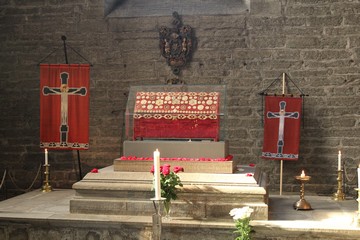 Relic Shrine of St. Birgitta
Relic Shrine of St. Birgitta
1. Abbey Church
In the church there are several mediaeval objects, among them several altars and the two best-known
Birgitta statues, the "realistic" and the "visionary" Birgitta. Birgitta's reliquary contains remains of both
Birgitta and her daughter Katarina.
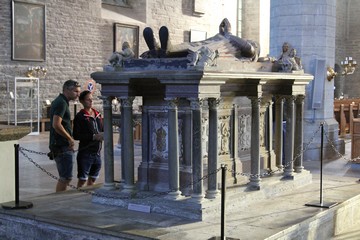 Grave monument of Duke Magnus
Grave monument of Duke Magnus
During summer the church is visited daily by 2500-3000 people. It has three stars in the green Michelinguide, so it is worth a trip of its own.
Guided tours for prebooked groups
Guided tours of Vadstena Abbey Church are organised throughout the year during opening hours, also in combination
with other guided tours, e.g. city walks, Birgitta walks, guided tours of the Sancta Birgitta Abbey Museum and more.
You can find out more under
Book a guide.
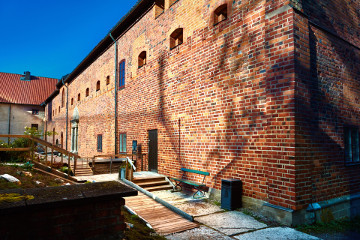 Royal Palace - Photo: Anders Malm, www.sldfoto.se
Royal Palace - Photo: Anders Malm, www.sldfoto.se
2. Royal Palace
The palace was built in the sixties of the 13th century by King Valdemar, Birger Jarl's eldest son. It is the
best-preserved medieval palace in the north and Sweden's first secular, non-sacred brick building. The palace
is built with high quality throughout and exudes luxury.
In 1527 the Reformation was carried out in Sweden and all monasteries were closed. The monastery of Vadstena continued to exist until 1595, when the last nuns were expelled. After that, the monastery area was rebuilt to accommodate war invalids from all battlefields of the Great Power era. During the reign of Queen Kristina, the first permanent home for the disabled in Europe was completed. After that, the nunnery became a correctional institution for a short time, a kind of prison, and in 1829 a mental hospital.
After the psychiatry had left the premises in the 1950s, the monastery buildings were to be renovated and rebuilt. Two important discoveries were made: firstly, the main building of the nunnery with its dormitory was preserved, and secondly, the building consisted of the 13th century royal palace of folkungers. It was assumed that the palace had fallen victim to the construction of the monastery. In 2016, we celebrated the 60th anniversary of both discoveries on August 26 and November 19, respectively.
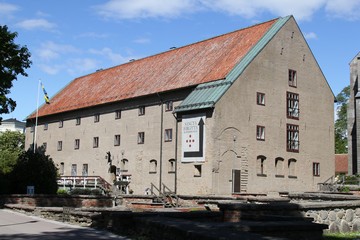 Monastery Hotel
Monastery Hotel
3. Nunnery (west wing)
The oldest part of the building is the kitchen of the Royal Palace. The house was converted into the west wing
of the nunnery and contained the nuns' kitchen as well as the winter and summer dining room. The winter dining
room could be warmed up with a hypocaust. That is in good condition and can be found under the entrance altane.
In 1646, a floor was added and the building was extended. Since then, the nuns' cloister has been the corridor on the side of the inner courtyard (Gräsgården).
In the 1960s, the house was converted into a guesthouse of the Birgitta foundation and became the Vadstena Klosterhotel in 1988.
4. House of Hjertstedt (Klostercafé)
On the bank of Lake Vättern lies a small house, also known as Hjertstedtska House. It was built in the 18th century
as a priest's apartment for the Veteran's home.
When the "Kurhus" was opened in 1795 in the old monks convent, the building received a new use as a doctor's apartment and its name after Ludwig Magnus Hjertstedt, who was the town doctor of Vadstena from 1840-1849 and senior physician at the Kurhus and Vadstena Hospital from 1846-1868.
The monastery hotel operates the comvent café in the building and surrounding garden during the summertime.
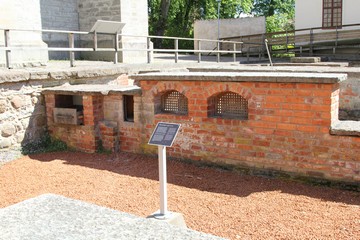 Ruin park, consultation house
Ruin park, consultation house
5. Ruin park
The ruin park was created after archaeological excavations in the 1920s unearthed foundations that belonged to
the monastery's consultation house, brewery and bakery.
Nuns and monks lived separately from each other in their convents, but in the speaking house they were able to communicate with each other through hidden wooden grids. There was also a rotary drum and a drawer, which could be used to exchange objects without visual or physical contact. The revolving drum and drawer were restored to show visitors how the exchange could have taken place.
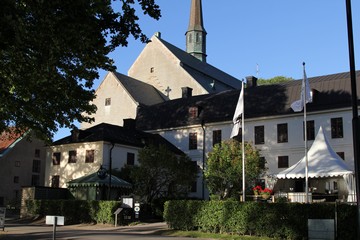 Friary
Friary
6. Friary
From the old monks concent there is nothing more to be seen from the outside. The building was completely rebuilt
in the 1760s, when the upper floor was added as an apartment for the inspector of the Veteran's home. On the ground
floor, on the other hand, is the monks' residential wing with its chapter room.
Twelve years after the closure of the “Krigsmanshus”, a so-called "Kurhus" started its service. Kurhus was a hospital for venereal diseases with space for 48 patients. In 1847 it became the town's general hospital.
Today, the restaurant Munkklostret ("Friary restaurant") and the reception of the monastery hotel are located here.
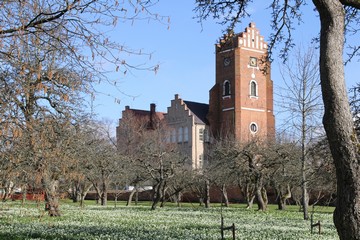 Monk's Garden and Red Tower
Monk's Garden and Red Tower
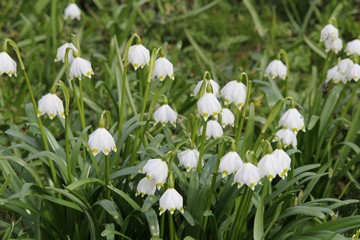 Spring snowflakes in the Monk's Garden
Spring snowflakes in the Monk's Garden
7. Monk's Garden
The park south of the church was originally the monk's garden. Here you will find one of Sweden's oldest and best
preserved orchards with apples and pears. Tens of thousands of spring snowflakes flower here in March.
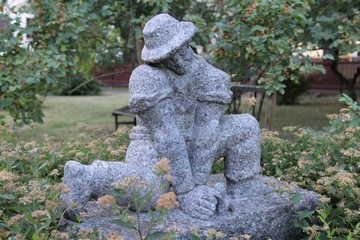 Herb Garden. Johan Peterson's statue
Herb Garden. Johan Peterson's statue
8. Herb Garden
The herbal garden in its present form was created in the 1980s. The ground-breaking ceremony took place in 1983.
The original herb garden was planted 600 years earlier and in approximately the same place. It was Johan Peterson, squire of St. Birgitta, who set up the garden. We do neither know exactly what it looked like that time nor which plants were grown there.
Today's herb garden contains various quarters, which contain different types of plants such as medicinal plants, spices and ancient garden plants.
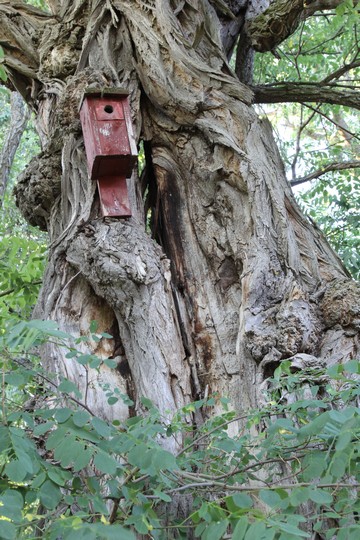 Herb Garden, Robinia
Herb Garden, Robinia
Above the plantings there is a rosarium located with mainly older rose species. An old Robinia is centrally placed.
9. Isbergian House / Lower Monk's Garden
The lower monk's garden was privately owned from 1849 to 1916.
A so-called parstuga was transferred to this part of the monastery garden. The brothers Regenstrand, who were responsible for the food supply of the hospital, lived there. The house was later extended with an annex. Today it is called Isbergian House, after a teacher who later lived there.
A barn on the corner of Murgatan/Klostergatan was demolished in the 1850s and a residential wing was built on the same site.
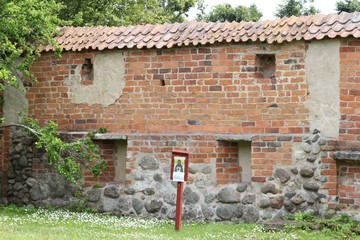 Monastery wall with House of the Beguines
Monastery wall with House of the Beguines
10. House of the Beguines / Monastery wall
In 1506, the monks extended their garden significantly to the south and built a new brick wall around the enlarged
garden. They expelled the Beguines, a free convent of lay sisters who had their house on the Klostergatan street.
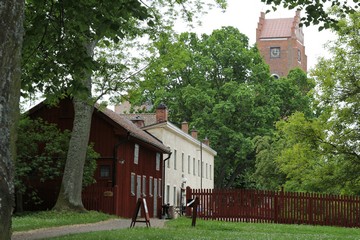 Monk's Garden with Pilgrimage Centre, Red Tower in background
Monk's Garden with Pilgrimage Centre, Red Tower in background
11. Pilgrimage Centre
The pilgrimage centre in Vadstena is a centre for all pilgrims of the country and is run by the diocese of
Linköping in the Swedish Church. It is a meeting place for people on their way. Here you have the opportunity
for hikes, tranquillity, reflection and new encounters.
The bakery building from the hospital's time includes a guest house, café, pilgrim shop and chapel.
Pilgrimcentrums Café
Enjoy homemade bread and hot drinks in a lovely and relaxing environment. Summer open Tues-Sat 10-16, other
times Tues-Fri 10-16. Closed 1/12 2024 - 16/1 2025 for day visitors due to renovations.
0143-105 71 or 013-24 26 84 (Café manager).
Restaurant Munkklostret
0143-130 00.
Vadstena Klostercafé
Open during the summer.
0143-130 00.
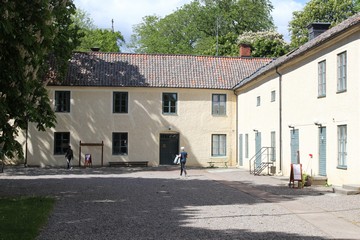 Old Theatre
Old Theatre
12. Old Theatre
Kronoinspektor Olof Regnstrand was responsible for the food supply of the hospital and rented the monk's garden
from 1798 onwards, making it accessible to the inhabitants of the city and creating a hermit's cave and a pleasure
house near the church. In 1826, Regnstrand's new "Assemblésalon" was inaugurated with the play "The Crusaders"
by August von Kotzebue.
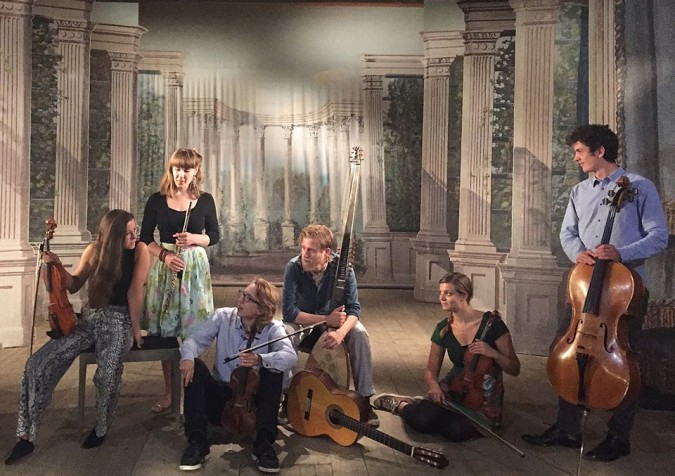 Soloists of the Vadstena Academy in the Old Theatre
Soloists of the Vadstena Academy in the Old Theatre
The Assemblésalon was conceived as a dance hall, but could also be used for theatre performances. He was Sweden's first country theatre. In 1847 the theatre received its present appearance and at the same time the building was extended to the south with a residential wing. Today, theatre and house are managed by the Vadstena Academy.
In 2025, the Old Theatre will be 200 years old. Under the theme Vadstena Gamla teater - 200 år av liv och lust! (The Old Vadstena Theatre - 200 years of life and lust!) the Vadstena Academy is honouring the anniversary.
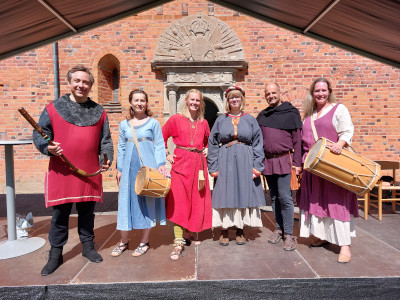 Gräsgården Singers, Palace festival 2023
Gräsgården Singers, Palace festival 2023
13. Grassgarden (Gräsgården)
The inner courtyard of the nuns was surrounded by a cloister that connected the monastery buildings. Here the
nuns were growing roses and white lilies, symbols of the Virgin Mary's purity. The grass symbolized eternal life.
Shakespeare was played on Gräsgården every summer until 2018.
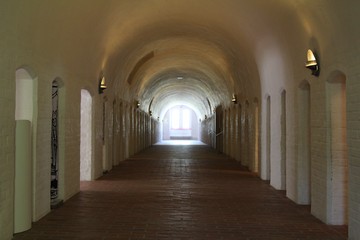 Dormitory in the Sancta Birgitta Klostermuseum
Dormitory in the Sancta Birgitta Klostermuseum
14. Sancta Birgitta Klostermuseum
The palace now houses the Sancta Birgitta Klostermuseum. The museum offers daily guided tours during regular
opening hours, covering the history of the monastery area, life in the palace, monastery life, medieval monasteries
and Birgitta's life and work.
Open all year round. Guided tours and group visits are possible.
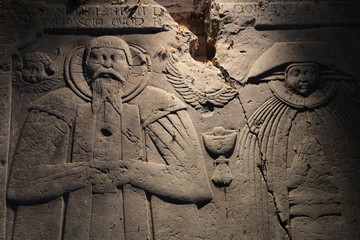 (Grave) Stone Museum in Trossboden
(Grave) Stone Museum in Trossboden
15. Trossboden
The Trossboden is a former coach hall of the Royal Leibgrenadier Regiment from the beginning of the 19th century
and belongs to Vadstena parish. There is an exhibition of gravestones from the monastery church.
16. Nun's Garden
North of the monastery building and on the lake side there was a nun's garden with orchard, vegetable garden
and herb garden. The sisters also cultivated medicinal plants there.
It was not until the beginning of the 19th century that the nun's garden was built on and a park was created there. For example, the so-called Empirevilla was built there around 1840, the first-class department of the women's hospital, and in 1860 the gate house in the monastery wall. The tower building was added in 1898. The entire area is used by the Vadstena Adult Education Centre.
The restaurant of the adult education centre is located directly on Lake Vättern's shore.
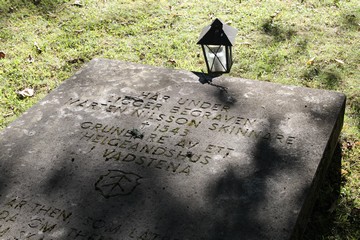 Mårten Skinnares grave
Mårten Skinnares grave
17. Churchyard
In order to receive visitors from near and far, the churchyard was built east of the monastery church.
It was a meeting place, only a small part of it was used as a cemetery.
The wall in the north was part of the 13th century royal court. Even the western Wall is from this period. The eastern wall to the Lastköpingsgatan can be dated around 1400. The gravestone (more precisely a copy) of Mårten Nilsson Skinnare, who died in 1543, is located there, very close to the gate at the Lastköpingsgatan. 1519 Mårten Skinnare took the initiative for a hospital foundation. Vadstena Hospital was to become one of Sweden's largest and most important health facilities.
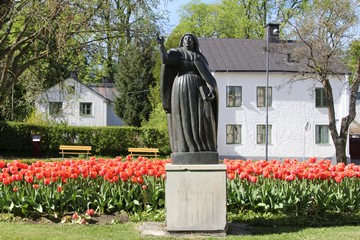 Statue of St. Birgitta and Mariagården
Statue of St. Birgitta and Mariagården
18. Mariagården
Mariagården was the convent of the Daughters of Mary in Vadstena, before the sisters moved to their new convent,
Hl. Hjärtas kloster
(Convent of the Sacred Heart), at Omberg. After several years as a treatment centre and then as part of the
pilgrimage centre, Mariagården will be used as a private residence from 2025.
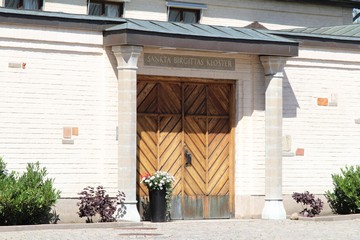 Bridgettine's Abbey Pax Mariae
Bridgettine's Abbey Pax Mariae
19. Bridgettine's Abbey Pax Mariae
In 1935 the Swedish branch of the Birgittenorden, founded by St. Elisabeth Hesselblad, bought a house in
Vadstena and set up a guest house there. In 1954 the guesthouse was extended.
In 1963, nuns came to Vadstena from the Birgitten Monastery in Uden in Holland and reintroduced the original monastery rule. Ten years later, the new church and convent were inaugurated.
The cloister, which is not open to the public, has room for twenty nuns and a traditional "grassgarden" surrounded by a high brick wall. On the outside of the wall there are fragments of stone from various Birgitten monasteries.
20. Abbey Church Pax Mariae
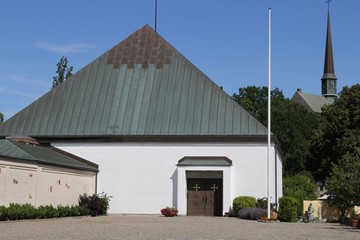 Abbey Church Pax Mariae
Abbey Church Pax Mariae
21. Guesthouse of the Bridgettines
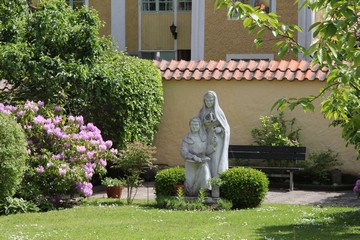 In the garden of the guesthouse
In the garden of the guesthouse

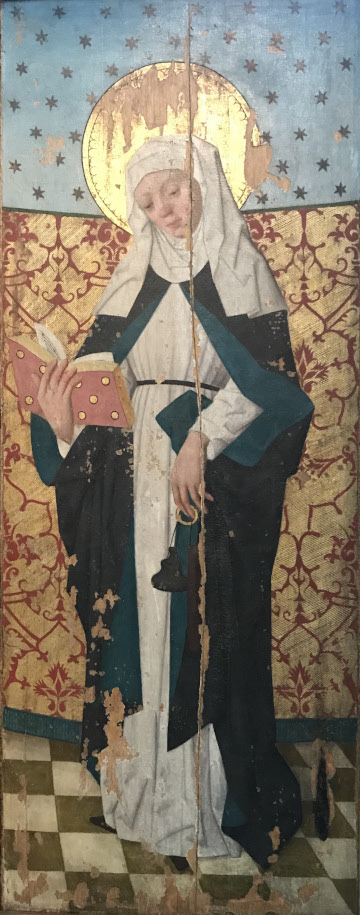
The Sancta Birgitta Klostermuseum is a historical museum with an emphasis on the Middle Ages and the cultural heritage left by St Birgitta. The museum is located in the building where many of our stories take place, tarting in the palace that Birger Jarl had built for his son Valdemar in the 1260s.
The feasts of the knight's age are turned into the monastic life of Birgittaorden It is a rich story that takes us on a journey through time, through war invalides home, mental hospitals and now a museum.
Opening times 2025
11 January - 12 April: Saturdays 11-17.
Winter sport holidays (17-21 February): Daily 11–17.
14 April – 1 June: Thursday-Sunday 11-17.
Easter school holidays (14–18 April): Daily 11–17.
2 June - 31 August: Daily 11–17.
Midsummer Eve (Friday 20 June) closed.
September: Thursday-Sunday 11-17.
October - December: Saturdays 11-17.
Autumn school holidays (26-28 October): Daily 11–17.
Christmas school holidays (26–28 December): Daily 11–17.
Guided theme tour (in swedish) on all open days 12 and 15.
The museum's knowledgeable guides will take you on a journey through Swedish history from Birger Jarl's 13th century to Swedish women's suffrage and all the way to how St Birgitta can inspire us today.
Themed tours can be booked in Salver, and if space is available, tickets can be purchased at the museum shortly before the tour.
The museum is open for booking all year round.
Admission museum
Adults: 100 SEK.
Children and teens (up to 17): free
Admission museum and guided theme tour
Adults: 150 SEK.
Children and teens (8-17): 50 SEK.
Contact
+46-143-100 31
 Grave monument of Duke Magnus
Grave monument of Duke Magnus
 Relic Shrine of St. Birgitta
Relic Shrine of St. Birgitta
In the revelations of St. Birgitta there are detailed specifications on how the monastery and church should be built. The church was to be simple, humble and strong, a hall church with three naves of equal height, fifteen cross vaults without painted windows, with whitewashed interior walls. Limestone from the quarry in Borghamn, south of Vadstena, was used as construction material.
The monastery was built as part of a awakening movement, and the monastery grounds were designed to accommodate visitors from near and far. In order to make room for a large, open meeting place, the church received its entrance in the east with the high altar in the west, completely contrary to ecclesiastical custom. The pilgrims had access to the church corridor, while the nuns' choir was located on a gallery in the nave. The monks had their choir in the western part of the church. The monastery was consecrated in 1384 and the church in 1430.
In the church there are several mediaeval objects, among them several altars and the two best-known Birgitta statues, the "realistic" and the "visionary" Birgitta. Birgitta's reliquary contains remains of both Birgitta and her daughter Katarina.
Language: Swedish, German, English
Time: 1 hour
Participants: max. 30 people / group and guide
Price:
Monday-Friday: 1500 SEK incl. VAT
Saturday/Sunday/Holiday: 1875 kr. inkl. Mwst
Mini groups:
Monday-Friday: 120 SEK per person, minimum 720 SEK incl. VAT.
Saturday/Sunday/Holiday: 150 SEK per person, minimum 900 SEK incl. VAT.
Admission to the abbey church:
30 SEK/adult plus 250 kr per group with guide.
The tour of Vadstena Abbey Church can be concluded or combined with a visit to the
Sancta Birgitta Klostermuseum or a
city walk.
UpplevVadstena AB
Skedagatan 208, 592 93 Borghamn
+46-143-201 19, +46-76-765 1317